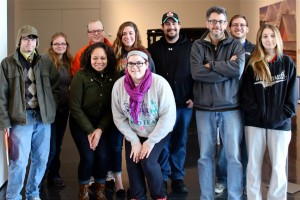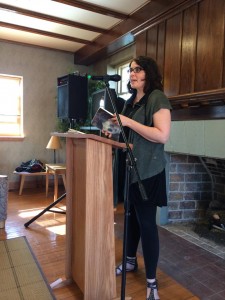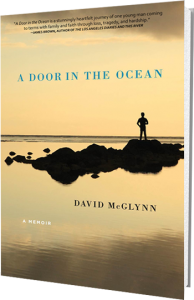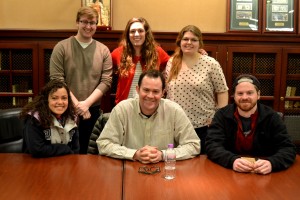Going Public
Going Public
What is Literary Citizenship?
Writer and professor Cathy Day, the leading voice in ongoing conversations about literary citizenship, says that most of those who love language and literature enough to become writers also exhibit a real
As aspiring writers in Monmouth College’s Spring 2014 ENG 310, we’re coming to understand that we need to do more than just write or hope to get published, but in Day’s words we have to
“work to create a world in which literature can thrive and is valued.“
Drawing on the whole conversation that Day and others are having, we think for writers and readers at Monmouth College literary citizenship means:
The literary community is a network of people who actively and openly read and write. To engage in literary citizenship is to be a part of this community, which involves the crucial acts of buying, reading, reviewing, and promoting books in order to support aspiring and professional writers, as well as encouraging a reading culture.
To help encourage people to be part of this community, we’ve collected 13 Ways of Being a Literary Citizen.
We want to direct you to the many fabulous resources already available at Monmouth College.
And we’ve identified ways to help the future of Literary Citizenship at Monmouth look even stronger.
Are you a student at Monmouth College, or a member of the Monmouth community, looking to become a more engaged literary citizen? At Monmouth, there are several options for writers and readers who wish to become better, more engaged, literary citizens.
Creative Writing Courses:  For students who wish to improve their writing and challenge themselves with new genres of writing, or simply gain appreciation for the type of work that goes into writing well, Monmouth College offers two creative writing courses:
For students who wish to improve their writing and challenge themselves with new genres of writing, or simply gain appreciation for the type of work that goes into writing well, Monmouth College offers two creative writing courses:
ENGL 210: Intro to Creative Writing
In this course, students aim to develop reflective habits of reading and writing that will aid them in becoming more accomplished writers of poetry, fiction, and creative non-fiction. In addition to sharpening their writing skills, students learn how to support and critique their peers and other writers. By the end of the term, students develop awareness of effective creative writing and of their own strengths and weaknesses as a writer in all three genres, as they produce a portfolio that provides evidence of their growth as writers.
ENGL 310: Advanced Creative Writing
An extension of Intro to Creative Writing, students in Advanced Creative Writing are given the opportunity to develop their capacities as reflective readers, considering what it means to read as a writer. Writers generate, draft and polish an extended piece of collection of prose, poetry or drama. The goals is to also become more careful readers of their peers’ work, offering constructive feedback in a workshop format and to begin to understand and enter into the larger public life of creative writing by means of exposure to publishing outlets, editorial projects, attending public readings and submitting selected work for possible publication, and ultimately, to consider their roles as literary citizens.
For students interested in publishing their writing, Coil is a creative arts magazine that is published annually by the students of Monmouth College. Students and faculty of the college may submit works of original literary or visual art, which are reviewed and chosen by a student editorial staff. The publication is distributed each spring.
Annual Reading Series During the 2013-2014 academic school year at Monmouth College, we were lucky enough to have a record breaking number of visiting writers come to campus and read their work as a part of our readers’ series.

These readings are open to the public, and are promoted on the college website, social media pages affiliated with the college (Facebook, Twitter) and bulletin boards all over campus.
Countless acts of literary citizenship are already listed here, here, here, and here. But here are our top thirteen ways of being a literary citizen:
1) Social Media: Follow #litcitizen posts on Twitter and work to promote the work of writers you enjoy on Twitter, Facebook, Tumblr, etc. Rule of thumb: for each time you talk about your own writing, mention someone else’s work five times. A great example is fiction writer Kyle Minor who used a great review in the NYTimes Book Review as a chance to mention other writers he admires.
2) Spread the word: Share publications and articles that might interest others and make them involved with literary events. This world is full of information and facilitating good quality articles is a good way to stay informed and help others stay informed as well.
3)Support the writers: The most obvious way of supporting is buying. Try buying at independent stores around your neighborhood. A subscription to a magazine or literary journal is always an option to keep yourself engaged and supportive of the literary community. These are two web pages suggested by Sambuchino to find the store closest to you: Indie.org and Powells. He also suggests the program by the Council of Literary Magazines and Presses for those professors and students who want to incorporate magazines in their courses.
4) Books: Don’t just buy them. Turn the individual reading process into a social process by sharing what you think. Talk to your friends about what you are reading. Even if they are not the most book friendly people, whenever they feel like reading a book, they will come back to you for recommendations. Use any of the ideas triggered by a book in your conversations. This will make people (and even yourself) realize the value of reading.
5) Get caught!: (Reading) Take your books and go read at the park, at the bus stop, at the train station, and (why not?) at the bar. Let people know that reading remains a commonly enjoyable pursuit.
 6) Attend literary events: The more events you attend, the more you will learn about your own reading taste, in addition to meeting new people that share the same interests as you do.
6) Attend literary events: The more events you attend, the more you will learn about your own reading taste, in addition to meeting new people that share the same interests as you do.
7) Build your own literary network and help others, too: Introduce a friend to another friend with similar literary interests. Invite your friends to literary events you think might interest them. Keep inviting your friends even if they don’t go at first. They will show up one day and even bring their own friend.
8) Stick to those you trust: Here are ways of finding a writing group. With time you will learn who it is you like to work with. Keep them close to you as reading and writing advisors who share and review work with you. They will be familiar with your style and your projects and will serve as excellent reviewers and proofreaders.
9) Don’t forget the future: Don’t underestimate the power of reading to kids. Frequently, reading habits are learned when parents read to their children routinely. If you have little ones in your family, sharing a fun book with them could be the key to instill curiosity for reading in them.
 10) Share the love: Did you like the last book you read? Did it change your perspective of life in some way? Were you impressed by the writing style? Then say it. Let the author know that you appreciate their work by an email or a letter. Even if you don’t get an answer, writers will always be moved by honest and smart responses to their work.
10) Share the love: Did you like the last book you read? Did it change your perspective of life in some way? Were you impressed by the writing style? Then say it. Let the author know that you appreciate their work by an email or a letter. Even if you don’t get an answer, writers will always be moved by honest and smart responses to their work.
11) Create a blog: Blogging is a great way to let the world know what you have to say. Write book reviews, post about recent authors, give a space for people to comment on the books they have read and for local authors to promote their work.
12) Join a book club: A book club is the perfect way to keep yourself engaged in active reading, and helps to promote and organize social literary events.
13) Volunteer work: Involve your community in the reinforcement of a reading and writing culture. Start your own book club, read to the kids in the library, work with the library to organize events for local authors, donate your old books to people who would appreciate them or proofread others’ drafts.
Any other idea or response on how to be a literary citizen? Let us know with a comment!
 Speakers!
Speakers!
This year we have had ten different writers on campus
This is a literary experience that should be continued and even expanded. In the future, it would be excellent to partner with different groups on campus. The English Department could work with Spectrum, Women’s Studies, or a number of different groups on campus to help bring excellent speakers and readers who would appeal to each group.
Same Time, Same Place
As students and faculty at Monmouth are extremely busy, making time can be difficult. So, having literary events at the same time and possibly the same place each month would make it easier for people to not only make room, but simply to remember. This link would be excellent to use each month to figure out a theme or event to put on.
“Eat, Drink, and be Literary”
This blog post is about the authors favorite bookstores and literary events. Some of these would be awesome to adapt to Monmouth. For example, the event “Eat, Drink, and be Literary,” is something that could be adapted at Monmouth. Or, we could have an event where literary folk share their favorite books and shops, essentially a review session.
Reading Marathon
We already have an actual Faculty Poetry Reading each April. Another interesting idea for Monmouth is a poetry marathon. This is becoming more and more popular and can be done in many different ways. If the right author was selected, the project could be a huge success. Attached is a link that explains how this could work based on how it has been done at another school.
There are a number of varying ideas within the community’s discussion of what it means to be a literary citizen, but here we’ve compiled several quotes which we believe best represent the concept.
Our own Advanced Creative Writing class has defined literary citizenship as the following:
The literary community is a network of people who actively and openly read and write. To engage in literary citizenship is to be a part of this community, which involves the crucial acts of buying, reading, reviewing, and promoting books in order to support aspiring and professional writers, as well as encouraging a reading culture.
Cathy Day has established some of the more widely known concepts of literary citizenship:
Bethanne Patrick’s Being a Good Literary Citizen: A Manifesto says:
“Anyone is a potential literary citizen and everyone who takes on the mantle of said citizenship should be interested in making sure excellent books of every kind continue to be available.”
Lori May considers the ecosystem of writers and our responsibility to tend it:
“Simply put, literary citizenship is a topical term for engaging in the community with the intent of giving as much as, if not more so, than we take. Our literary world is a social ecosystem that relies on others: readers, writers, editors, reviewers, publishers, booksellers, and so on. The writing and publishing world is one made of relationships. Writing itself may be a somewhat solitary activity, but once the story or poem is ‘done’ we rely on others to read, share, and publish our work. Yet there are so many levels of participation from others in this community.”
“Literary citizenship calls on our acts of giving, of giving back to the ecosystem so that we may actively ensure its sustainability.”
And Becky Tuch, in Salon, challenges the conversation and our rush to embrace literary citizenship as a term and idea:
“It’s just that in all this talk about what makes a good Literary Citizen, it seems we have missed a key step: critical reflection. Isn’t it important to ask why things are the way they are? The notion that the system ought to be challenged, that there is even a system within which all this is operating, is notably absent from discussions about being a good Literary Citizen.”
Below are the sources to consult for your synthesis/sourced essay. Please refer to the prompt distributed in class for more details on the particular expectations for the assignment.
To add to the great assistance Lauren Jensen will be offering us here are useful links to get your research going.
Please note: these are reliable beginning places but no substitute for careful close reading of our primary texts and smart searching of the literary reference works and databases we have available on campus.
I will take a bit of our class time to give even more instruction on how to chart out your research for your working notes and the research essay.
Assignment
Choose one of two fixed forms in which to write a poem: a sonnet or a pantoum. Before you attempt your own poem, you should read the comments and links below including the sonnets and pantoums to which I’ve linked, as well as perhaps digging through some anthologies for formal pieces that strike you. Here are a few key notions I would like you to remember about writing fixed forms.
Entering the Poetic Tradition
Forms that seem prescriptive to us were once merely descriptive. The codified “rules” of writing sonnets or ballads or pantoums (or Hebrew acrostic poetry) often were compiled after years and years of experimentation by writers and singers. After these artists found ways of shaping language to their needs (and to the needs of their culture), they continued to use those familiar shapes, pouring new language and notions into their past successful methods until, after a time, others copied them. And after still more time others broke with and altered these forms to meet new needs and linguistic developments. Attempting to write in these forms is a way to enter into that poetic tradition, to understand more fully how the language works, and to see how the language has changed over time. It will make you both a better writer and a better reader if you understand some of these forms from the inside out.
Form and Function
At first, writing formal poems will seem like linguistic calisthenics. However, after more experience with forms, you might find that particular forms actually prove useful as a means of dealing with particular subject matter. For instance, I was attempting to write a poem about my wife’s grandfather, a man who worked for many years as a mason. It wasn’t until I discovered the pantoum that my poem began to work. The interlocking layers of the language and the rhythmic repetition turned a rather distant portrait of a long dead relative into a meditation on the act of making things, of choosing one word or brick over another. Be conscious, then, of how the forms you investigate fit themselves especially well to certain subject matter.
No Archaic Language
Wordsworth, Donne, Keats, and Shakespeare used the language of their day. Though the forms may be old, it’s important that you also attempt to write using a contemporary version of English–both in terms of diction/word choice and syntax. If part of the exercise is to learn how the language works, you need to use the language as it has evolved. So avoid “thee” and “thou” and be conscious of the effects of flipping word order. Using occasional enjambment and/or slant rhymes is one way to avoid archaic sounding lines.
An Elizabethan Sonnet: While English speaking poets write three main types of sonnets (Petrarchan, Spenserian, and Elizabethan), I think it’s easiest to begin with the Elizabethan or Shakespearian sonnet. Here are the major elements of the form
Length and Rhyme Scheme: A sonnet consists of 14 lines of rhymed iambic pentameter. The rhyme scheme occurs in sets of quatrains, or four lines, with every other line rhyming. For example, Shakespeare’s Sonnet 73 has these three quatrains:
That time of year thou mayst in me behold, a
When yellow leaves, or none, or few do hang b
Upon those boughs which shake against the cold, a
Bare ruined choirs, where late the sweet birds sang. b
In me thou seest the twilight of such day, c
As after sunset fadeth in the west, d
Which by and by black night doth take away, c
Death’s second self that seals up all in rest. d
In me thou seest the glowing of such fire, e
That on the ashes of his youth doth lie, f
As the death-bed, whereon it must expire, e
Consumed with that which it was nourished by. f
The poem ends with a rhyming couplet:
This thou perceiv’st, which makes thy love more strong, g
To love that well, which thou must leave ere long. g
Octave and Sestet Besides being grouped by rhyme scheme, most sonnets also follow another sort of organization, one that is more an arrangement of thought or feeling. The first either lines, or octave, usually pose a problem or question. The final six lines, or sestet, then respond with a solution or answer. This requires a kind of turn, or volta, between the octave and sestet.
Meter and Rhythm
Each line in a sonnet utilizes iambic pentameter, historically the most common meter in English poetry. An iamb, or foot, is composed of two syllables, with the second syllable being the one that isemphasized. Each line in iambic pentameter consists of 10 syllables, or five feet:
when I / con SID / er HOW / my LIFE / is SPENT
that TIME / of YEAR / thou MAYST / in ME / be HOLD
Of course when you read a sonnet aloud, you don’t necessarily ride the emphasized syllable. And sometimes, you may want to break with the standard pattern of unstressed/stressed. But this underlying rhythmic pattern is a basic part of a sonnet.
Subject Matter
Sonnet actually means “little song,” and as such sonnets were typically lyric poems about love, most often romantic love. Nearly as often, sonnets have been meditations on God, mortality, or nature. The octave/sestet structure often fits these subjects especially well, as the speaker in the poem raises a question about love/God/death and then finds his or her way towards a temporary answer. Don’t feel constrained, however, by these historical subjects. Try several subjects and see what the form does to shape your thinking about them.
Some Sonnets in mostly contemporary vernacular
Unholy Sonnet–Mark Jarman (Look especially at the one beginning “Think of the harsh attire that God put on”)
First Fight, Then Fiddle–Gwendolyn Brooks
The Pantoum
A pantoum is a Malaysian form of poetry that relies on interlocking, repeating lines, not unlike the French villanelle. Unlike a villanelle, however, the repetitions in a pantoum only move from stanza to stanza. A pantoum is written in four line stanzas, or quatrains, in which the second and fourth lines of one quatrain become the first and third lines of the next quatrain. There is no fixed line length or topic, and in English the pantoum does not necessarily rhyme. Here is a pattern of the form:
Stanza 1:
Line 1
Line 2
Line 3
Line 4
Stanza 2:
Line 5 (repeat of line 2 in stanza 1)
Line 6 (new line)
Line 7 (repeat of line 4 in stanza 1)
Line 8 (new line)
Stanza 3/Last Stanza:
Line 9 (line 2 of the previous stanza)
Line 10 (line 3 of the first stanza)
Line 11 (line 4 of the previous stanza)
Line 12 (line 1 of the first stanza)
You can read a similar explanation of the pantoum here orhere.
And here are a few samples:
Another Lullaby for Insomniacs–A. E. Stallings
First Pantoum of Summer–Erica Funkhouser
One sleep depletes, another fills the well
Our night’s companion shapes the coming day.
My bed this morning grew drafty as a cell
When you took off for town. I couldn’t stay.
Our night’s companion shapes the coming day,
And where we make our bed can make us weep.
When you took off for town, I couldn’t stay.
I fell into these woords—a second sleep.
Where we make our bed can make us weep
Or leave us a clean and clear and ravenous.
I fell into these words—a second sleep,
A summer sleep, the windows generous.
You left me clean and clear and ravenous.
I drank new air, a warm and welcome stream
Of summer sleep, the windows generous.
Here or away, you lead me out of dream.
I drank new air, a warm and welcome stream.
My bed this morning grew drafty as a cell.
Here or away, you lead me out of dream.
One sleep depletes, another fills the well.
Watching Ella Trip in Her Seventies–D. Wright
You can believe when Ella trips,
moving on stage, she’ll never get up,
this old woman with her broken hip,
her arm crooked like the handle of a cup.
Moving on stage, she’ll never get up
to the top of her range again. Again,
her arm crooked like the handle of a cup,
she arcs her neck, eyes closed, no strain
to the top of her range again, again,
beyond, within this body she has left.
She arcs her neck, eyes closed, no strain
and here’s the songbook she’s kept
beyond, within this body she has left.
She mimics Bird, and you think of his death,
and here’s the songbook she’s kept,
phrases like bursts of her own breath.
She mimics Bird, and you think of his death,
This old woman and her broken, hip
phrases like bursts of her own breath.
You can believe, when Ella trips.
Altar Piece–D. Wright